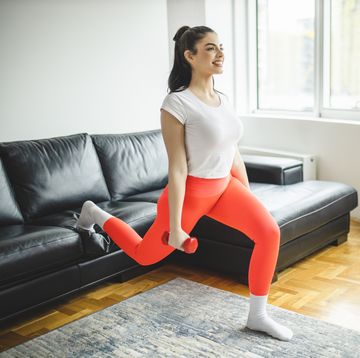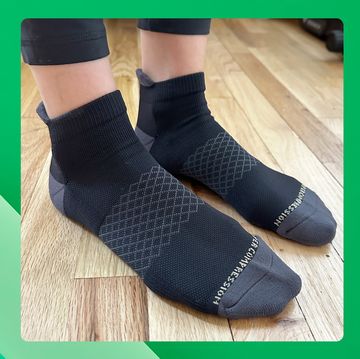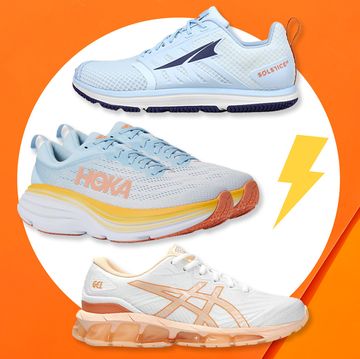Five years ago, Karen Soltero's workout routine was anything but routine.
"I'd try to go on runs, but I was really inconsistent, and I didn't see results," admits the 37-year-old Dallas-based photographer and writer. Then she met Alex. Since they started hitting the road together, Karen has dropped 10 pounds, finished two Olympic-distance triathlons, and stopped abusing her snooze button. "Alex motivates me to get out the door," she says.
"He's able to keep me going long after I want to quit."
Alex is the ideal running buddy: Part cheerleader and part drill sergeant, he's friendly but he doesn't let Karen slack off on her pace or bail on a workout. And all he expects in return? Belly rubs. Yes, it's that easy to satisfy this 9-year-old dog.
Studies are now confirming what Karen has learned: Canine owners are more likely to exercise regularly and to be fitter and healthier than their pooch-free peers. New research from Michigan State University reports that people with canine companions are 34 percent more likely to get the recommended 150 minutes of exercise a week than are folks with other pets (sorry, kitties) or none at all.
"A dog can do more for you than a treadmill," says Rebecca Johnson, Ph.D., an associate professor of nursing at the University of Missouri and coauthor of Walk a Hound, Lose a Pound: How You and Your Dog Can Lose Weight, Stay Fit, and Have Fun Together. "When you interact with a dog, endorphins rise and stress levels fall. This emotional connection gives an extra boost to your workouts."
When you consider that an energizer doggy can help you get fit, lose weight, and have fun in the process, a chewed-up pair of sandals becomes a worthy sacrifice.
You Move, You Lose
Research shows that dog owners often log in double workouts--they don't see taking the dog out as a sweat session, so they still spin and lift. But don't discount those walks. If you keep a moderate pace, you can burn up to 68 calories in 20 minutes. Indeed, a study from the University of Missouri found that overweight participants who walked dogs for 20 minutes five days a week for a year lost an average of 14 pounds. Throw in some high-energy games of chase, tug-of-war, and Frisbee, and you'll stoke your metabolism even more, says Gregory Florez, a certified athletic trainer in Salt Lake City.
Pure Energy
You'll never find anyone who loves to exercise more (Richard Simmons included). And that enthusiasm can be contagious. One Australian study found that dog owners felt more resilient to exercise barriers such as a busy work schedule or social life and felt more confident that they could find time for exercise regardless of other commitments. "A dog is always ready and willing to go," explains dog trainer J.T. Clough, author of 5K Training Guide: Running with Dogs. Plus, unlike a neighbor or your most dependable coworker, an ever-eager pup "never cancels on you at the last minute, complains about being tired, or backs down from rain or snow."
For that reason, University of Missouri researchers say the best exercise buddies very well may be the four-legged variety. They reported that people who walked with their dogs increased their speed by 28 percent over 12 weeks, while those who strolled with a (human) friend got only 4 percent faster. The reason? People tend to whine ("I hate hills!") or talk each other out of workouts ("Glee is on!"), says Johnson, the study's author. Dogs, on the other hand, are always game.
Follow His Lead
Have a race goal? You've just found your coach. Dogs are creatures of habit, and they'll help you stick to a training plan.
Once your pup gets into the routine of a morning run, you won't need an alarm clock--the wet nose in your face will work. And his steady tempo can also make you a legit speedster. "We don't realize how much our thoughts slow us down," says Clough. "A dog has a one-track mind; he'll push the pace."
Plus, if you're feeling tired or bored, you can feed off your companion's uppity demeanor, which can be a pick-me-up and take your mind off the miles, says Clough. And thanks to dog-friendly events (like Athens Run for the Dogs in Georgia, and Race for the Rescues in Pasadena, California, both being held this fall), you can even cross the finish line together.
Romp and Roam
There's no need to limit yourself (and your pooch) to walks around the block or runs in the park. Dogs crave adventure, and many breeds are perfect hiking, biking, in-line skating, or swimming buddies, says Clough. A word of caution: If your dog has a love of squirrel chases--and you have a dislike of wipeouts--rethink cycling and skating, or practice first in a parking lot where you can sharpen training cues.
You can also try a dog-friendly boot-camp class (there are several across the country). Leash Your Fitness in San Diego starts with a warm-up followed by cardio circuits. "Sprinting alongside your dog can help you step out of your comfort zone and increase your speed," says athletic trainer Dawn Celapino, who runs the program. Then, while your panting pal practices obedience commands ("Sit! Stay!"), you knock out a series of muscle-building moves like pushups and lunges. The workout wraps up with--what else?--downward-facing dog, a "doga" (yoga for dogs) pose.
Rescue Effort
Don't have a dog? You can still get in some canine workouts: Volunteer to run or walk a pound puppy (find a shelter at aspca.org). Research from the University of Missouri shows that people who walk shelter dogs tend to stick with their workouts because they feel committed to the animals.
Jeff Graves, founder of KC Dog Runners in Kansas City, Missouri, an organization that matches volunteers with rescue dogs for twice-monthly runs, agrees. "Virtually no one cancels, because there's this sense that the dogs really need the workout--and they do," he says. "Because the animals are able to release some of their pent-up energy, they show better to prospective adopters and are taken into good homes faster." Talk about exercise rewards.













